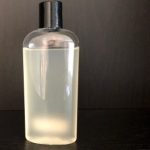Welcome to the beginners’ section of the blog. Here you’ll find everything you’ll need to start making your own products, including starting formulas for all kinds of things as well as my six ingredient lotion series, which will help you modify the lotions to make something you truly love.
Read this post first! How to get started making your own products: My journey, resources, and loads of information on where to begin…
No, seriously, read this post first. You will be so much happier for doing so, I promise. I share a lot of information in there with loads of links to formulas and where to start on your own formulating journey. It gives you ideas on where to start on the blog and what might be important as you take those first steps.
Then take a look at these posts!
- Defining our products!
- Tips & techniques!
- Downloads!
- Making products – specific formulas
- NEW! Series/course: Making lotions using four different emulsifiers – Newbie Tuesday from September to December 2020 (in progress) – click for the home page!
- Series/course: Making naturally compliant lotions using Ritamulse SCG
- SIX INGREDIENT LOTIONS
- Introduction to making facial products series/course
- Creating foamy, bubbly, lathery facial cleansers
- Creating hydrating toners!
- Creating gels!
- WHEN LOTIONS GO WRONG! The epic emulsion fails page! (Added January 11, 2020)
- CREATING PRODUCTS (IN MORE DETAIL)
- GENERAL QUESTIONS ABOUT FORMULATING (see above for tips & techniques as well!)
- DISCUSSION
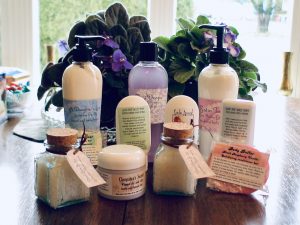 Defining our products!
Defining our products!
What you need to know about making any product (part 1)
What you need to know about making any product (part 2)
NEW! Beginners! Let’s talk about formulas – NEW for summer 2022!
How to read and convert formulas
How to convert from percentages to weight
Learning to formulate: Let’s take another look at converting from % to grams!
Learning to formulate: Learn to convert formulas from % to ounces!
Learning to formulate: Learn to convert formulas from % to ounces to make a 10 ounce batch!
Learning to formulate: Learn to convert formulas from % to grams, then make a bigger batch!
Back to basics: Defining terms for anhydrous products
Back to the very basics: Conditioner
Back to the very basics: Lotions
Back to the very basics: Shampoo
Learning about the skin feel of our oils
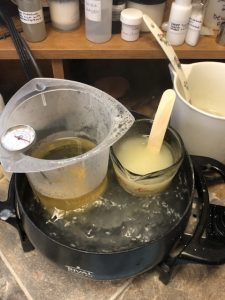 Tips & techniques!
Tips & techniques!
The formula is only the start: The importance of following the process exactly!
Tips & techniques: A few notes on the importance of process, following instructions, and measuring temperatures! Including how to melt ingredients in a double boiler, like Incroquat BTMS-50. This might be one of the most important posts I’ve ever written!
Tips & techniques: How to add new ingredients into a formula that contains water
Q&A: How do we determine how much emulsifier to use? (And the 25% rule for Polawax)
When making lotions, should we pour the water into oil or oil into water? – NEW (Summary: It depends on the emulsifier)
Don’t mix by hand – use a mechanical mixer of some sort – NEW!
Why do I suggest starting with a stick blender, then moving to a hand mixer with some emulsifiers?
Mixing! We held a Zoom meeting on mixers (click, then scroll to find the download for that workshop) in Spring 2020. There’s no video attached, but you can still download my handout on the topic.
Downloads!
Creating products – PDF of the basics, those I teach at the start of every class ($3 subscribers and up)
Making products – specific formulas
NEW! Series/course: Making lotions using four different emulsifiers – Newbie Tuesday from September to December 2020 (in progress) – click for the home page!
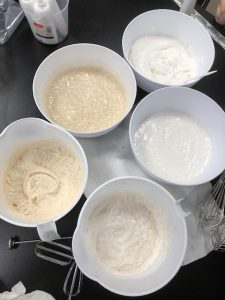 Series/course: Making naturally compliant lotions using Ritamulse SCG
Series/course: Making naturally compliant lotions using Ritamulse SCG
Tuesday, January 14th, 2020: Shopping lists for ingredients, supplies, and packaging as well as optional components.
Tuesday, January 21st, 2020: We took a look at the general formula we’ll be using for the hand lotions. I explained the formula, the chemistry of lotions, the reason we use preservatives, and the sensory characteristics we can expect with Ritamulse SCG. We compared emulsifiers, then I shared the basic format of the formula we’ll be following in this series along with an explanation about why we’re using the general ingredients we’re using.
Tuesday, January 28. 2020: We reviewed the ingredients we’re using in the formulas, and looked at why we might use them. I shared the formulas for the first hand lotion in both chart and PDF format along with all the instructions.
Tuesday, February 4th, 2020: We took a look at how to choose preservatives for our products. We took a look at all the questions I ask myself as I’m creating formulas to ensure I have the right preservative for the job. I shared a worksheet you could download in PDF form to evaluate your product and preservative. We also learned how to evaluate the efficacy of a preservative in our chosen products.
Tuesday, February 11th, 2020: It’s all about the sensory characteristics of the oils and butters we’re using as well as the sensory characteristics of the lotions as we make them. I shared my sensory characteristic chart so you can evaluate the ingredients and write down your thoughts as you work with your lotions.
Share your thoughts on your first lotion in this post from February 11, 2020! What did you think? What changes did you make? What did you like? What didn’t you like?
Tuesday, February 18th, 2020: Part one – questions, thoughts, discussions, and modified formulas for hand lotion #1.
Tuesday, February 25, 2020: Part two – questions, thoughts, discussions, and modified formulas for hand lotion #1.
Tuesday, March 10, 2020 – We created hand lotion #2 using a light, greasy oil and a light, non-greasy oil. There were a few PDF downloads – the sensory comparison chart of our oils, a blank sensory chart to use for your thoughts, and the PDF of the second hand lotion.
Tuesday, April 14, 2020 – We created hand lotion #3 using a little non-greasy oil, a little heavy oil, and a solid oil, babassu oil, to see what happens when we increase the viscosity a little.
Additional post: Testing the shelf life of your products: Observing a naturally compliant lotion for rancidity
Tuesday, April 28, 2020 – We started making body lotions by adding a butter – mango or shea – to see what impact they’d have on viscosity and sensory characteristics.
Tuesday, May 5, 2020 – We made our second body lotion with greasier feeling oils and shea butter.
Tuesday, May 12, 2020 – We made our third body lotion with slightly heavier oils and mango butter, and I shared a free download of my sensory characteristics chart so you can assess the skin feel of your products.
Tuesday, July 14, 2020 – We made our first body butter with mango or shea butter and heavier feeling oils.
Tuesday, July 21, 2020 – We made our second body butter with kukui nut oil and babassu oils! So luxurious!
Tuesday, July 28, 2020 – We’ll make our third body butter!
Tuesday, August 4, 2020 – Series/course wrap up!
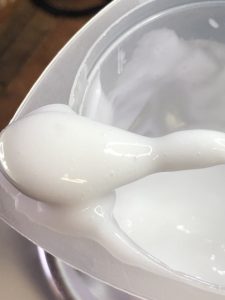 SIX INGREDIENT LOTIONS
SIX INGREDIENT LOTIONS
Challenge: Six ingredient lotions
Challenge: Six ingredient lotion – hand lotion with cetearyl ethylhexanoate & cocoa butter
Challenge: Six ingredient lotion with shea, soy bean & sesame oil
Six ingredient lotions: A great way to learn what you like!
Six ingredient lotion: Meadowfoam seed oil and cocoa butter
Six ingredient lotions: Rice bran & mango butter body lotion
Six ingredient lotions: Rice bran & mango butter body butter
Six ingredient lotion: Kukui nut & babassu oil with Polawax or e-wax (updated)
Six ingredient lotion: Kukui nut & babassu oil with Ritamulse SCG (updated)
Six ingredient lotions: Evening primrose, oats & chamomile hand and body lotion
Six ingredient lotions: Evening primrose, oats & chamomile body butter
Six ingredient lotions: Pomegranate & witch hazel facial moisturizer for men
Six ingredient lotions: Green tea & bamboo moisturizer
Introduction to making facial products series/course
Newbie Tuesday: We’re making facial products! – intro post!
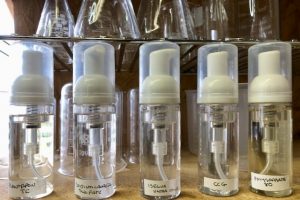 Creating foamy, bubbly, lathery facial cleansers
Creating foamy, bubbly, lathery facial cleansers
Let’s start making facial cleansers! – Formulating for your skin type
Facial products – the base formula
Facial cleansers – modifying them with humectants and cationic polymers
Did you make cleanser? What did you think? (part one)
Did you make cleanser? What did you think? (part two)
Did you make cleanser? What did you think? (part three)
Did you make cleanser? Submit your formulas!
Question: Can you add carrier oils to cleansers?
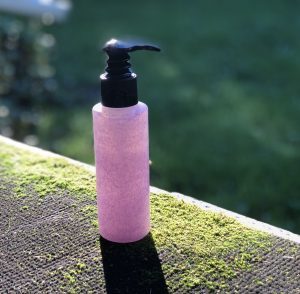
Newbie Tuesday on Monday: Modifying the formula with hydrolyzed proteins
Newbie Tuesday on Tuesday: Modifying the formula with aloe vera
Newbie Tuesday on Wednesday: Modifying the formula with botanical extracts (part one)
Newbie Tuesday on Thursday: Modifying the formula with botanical extracts (part two)
Newbie Tuesday on Friday: Modifying the formula with botanical extracts (part three)
Turning your cleanser into an exfoliating cleanser (part one) – physical exfoliants
Turning your cleanser into an exfoliating cleanser (part two) – physical exfoliants
Turning your cleanser into an exfoliating cleanser by adding chemical exfoliants
Modifying your facial cleanser into a foamer bottle formula
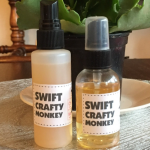 Creating hydrating toners!
Creating hydrating toners!
Creating a facial toner (part one)
Creating a facial toner (part two)
Creating a facial toner (part three) – cosmeceuticals
Newbie Tuesday: Creating a facial toner (part four) – adding cosmeceuticals (so many formulas!)
Creating gels!
Making a gelled toner with Ultrez 20
Gels, gels gels! Lavender & chamomile oil free gel moisturizer for normal skin types
Newbie Tuesday: Gels, gels, gels! Chamomile & cucumber oil free gel moisturizer for dry skin types
Newbie Tuesday: Using Sepimax ZEN to create an oil free moisturing gel
Newbie Tuesday: Making a gelled facial serum with oil using Sepimax ZEN
Newbie Tuesday on Wednesday: Making a gelled facial serum with AHAs (part one)
Newbie Tuesday on Thursday: Making a gelled facial serum with AHAs
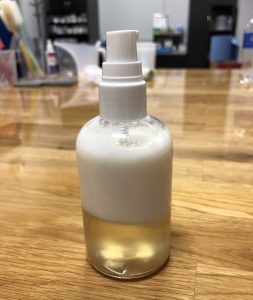 WHEN LOTIONS GO WRONG! The epic emulsion fails page! (Added January 11, 2020)
WHEN LOTIONS GO WRONG! The epic emulsion fails page! (Added January 11, 2020)
CREATING PRODUCTS (IN MORE DETAIL)
Creating products: Choosing your formulas
Creating products: A moment or two about finding formulas
How can you tell it’s a good formula? Do the math!
Creating products: Assembling ingredients – choosing your supplies
Creating products: Assembling ingredients – preparing your space
Creating products: Assembling ingredients – weighing and measuring
Creating products: Equipment (part one)
Creating products: Equipment (part two)
What options are there for double boilers?
Creating products: Equipment for measuring pH
Creating products: Polawax versus other emulsifying waxes
Creating products: Heating and holding
Creating products: Combining the two phases
Creating products: Combining the two phases – mixing
Creating products: Questions about mixing
Creating products: Cool down phase
Creating products: Packaging – too many choices
Creating products: Packaging – alternatives to bottles
Creating products: Packaging and preservation
Creating products: Filling our bottles
GENERAL QUESTIONS ABOUT FORMULATING (see above for tips & techniques as well!)
Vitamin E is not a preservative
You don’t need to add preservatives to anhydrous or non-water containing products
How do I modify a formula when I add or subtract an ingredient?
What if you go over 70˚C while heating and holding?
Heating & holding and graininess
How to test the temperature of your phases
When making stuff, how do you know what to do? (part one)
When making stuff, how do you know what to do? (part two)
How much stuff should I buy when I’m starting out?
What’s important in a conditioner? Part one
What’s important in a conditioner? Part two
Learning how to read a formula and convert it into weighted measurements – NEW!
Learning to formulate: How to a modify a formula when I add or remove an ingredient?
Learning to formulate: Small changes make a big difference!

